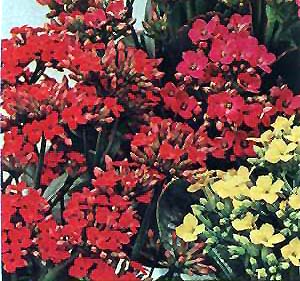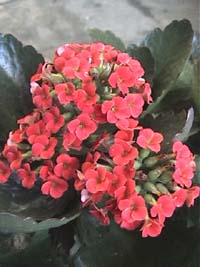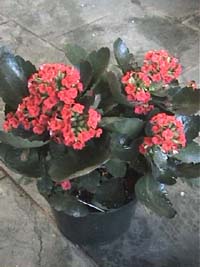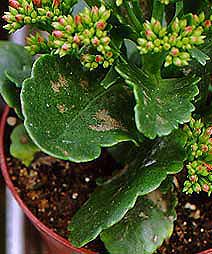|
Plants for your home
(By Mary Efanti)
Kalanchoe
 Origin - Description Origin - Description
Kalanchoe is one of the prettiest and infamous representatives of the succulents
family.
Although it is easily cultivated all over the world, it originates from
Madagascar while some creeping varieties were found the rain forests of Brazil and Southeast
Asia.
The plant was originally brought from Madagascar to Paris in 1927, while in 1928 a German merchant managed to grow it as a houseplant and started to trade it a few years
later, around 1932. His name was Blossfeld and the common variety of kalanchoe was named after him
(Kalanchoe blossfeldiana). The name kalanchoe came from a chinese word but it is still unknown how and when it was given to the
plant.
Blossfeld's kalanchoe is the ancestor of today plants. German and Swiss nurseries were the first to grow the plant with Americans shortly
after. The big breakthrough was in the 80s when Danish and Dutch growers managed to create the current
plant, a variety with compact shape, rich foliage, sturdy stems and plenty of
flowers. Starting in the 80s and still today, the beautiful red kalanchoe flowers that appear in groups on top of
stems, were developed in a variety of colors: yellow, orange, pink, purple, white and just recently
bi-colored varieties were created.
The plant is very popular to gardeners because of its long lasting flowers and attractive foliage while growers love it because it can be forced to bloom quite easily and can be sold in large numbers during Xmas holidays together with other seasonal plants
(poinsettias, cyclamens, Christmas cactus, e.t.c.).
Kalanchoe's leaves are fleshy, wide, oval-shaped, with indented edges, appear in turn throughout the
stems, are very tender and break easily.
Care
Kalanchoes are easy to grow, need warm temperatures and minimum care. In our moderate climate it can be as easily grown indoors and outdoors but only in pots and not in the
ground. Temperatures between 12 and 30´C are ideal for development and blooming of the
plant. Kalanchoe is very sensitive to cold and it takes only a few hours of near 0´C for the plant to
die. So, if you are aware of cold sprees move your plant indoors until weather warms up again or if you cannot do
that, cover it with plastic in order to protect it from freezing.
ďheir root system is extremely sensitive and it would be advisable to use clay pots that allow better aeration of the
roots. Ensure excellent drainage by placing pebbles at the bottom of the pot and use light soil containing lots of peat
moss, perlite and sand. Always empty excess water from the tray and never let your pot stand in
water.
Kalanchoe plants love to be alone in small pots. However, the larger the pot the larger the leaves but the size of the top will hardly affect blooming or rate of
growth. Avoid planting companion plants in the same pot with kalanchoes and repot each spring adding fresh
soil. Kalanchoes grow rather slowly, its average height is 15-45cm while in older plants the stems become
woody.
This plant loves and needs plenty of light to grow, if light is adequate its leaves will develop a beautiful redish
outline. During summer do not allow direct sunlight because its leaves who contain lots of water will get
sun-burned. Direct sunlight from fall till early spring will not harm your
plant.
 Provide plenty of water when the soil seems dry to the touch but do not overwater because the roots will
rot. If you have the time, let the water sit for a while before watering so that it will get the temperature of the
environment.
Provide plenty of water when the soil seems dry to the touch but do not overwater because the roots will
rot. If you have the time, let the water sit for a while before watering so that it will get the temperature of the
environment.
Kalanchoes can stand dry conditions but do not let them dry out completely because it will greatly compromise its
growth. The plant will need some time to get back into shape and avoid wetting the leaves when
watering.
Kalanchoes are usually bought or given as a gift with flowers. So, when the flowers start to die
back, cut them off and let the plant rest. After deadheading, you should reduce watering as the plant will need less water during this resting
period. Soon you will notice new buds and your plant will bloom again. This change in blooming and resting cycles will go on throughout the year irrelevant to
seasons.
You should however keep in mind that blooming of the plant is related to how much light the plant is allowed to
have. Several hours in darkness will enhance flower production. In other words, if you keep the light
(even artificial light) to 8-10 hours per day or less, you will help the plant produce new
buds. Following bud formation you can bring the plant back to regular lighting.
Anyway, plenty of light will enhance overall growth but will reduce blooming. Kalanchoes tend to bloom more from fall till early spring the reason being that days are shorter during these
months.
Fertilize every 2-3 weeks, using liquid fertilizer for flowering plants while you could also add an
all-purpose liquid or slow release fertilizer (in pellets) every now and then.
 It is easy to propagate kalanchoes through
cuttings. The best offsprings emerge from cuttings and not seeds as they used to do some time
ago. Also, the plants emerging from cuttings will bloom easier than the mother plant which has already bloomed one or more
times. It is easy to propagate kalanchoes through
cuttings. The best offsprings emerge from cuttings and not seeds as they used to do some time
ago. Also, the plants emerging from cuttings will bloom easier than the mother plant which has already bloomed one or more
times.
Usually, cuttings need two weeks until they produce roots and rooting hormone is not
necessary. Cut stems that are 5-8cm long and remove the bottom leaves. Fill a shallow pot with soil
(same as the one used for the mother plant) and place the stem in it up to the point where the last removed leaf
was. In this stage, water less often than mature plants. Place the pot at a shaded warm spot and wait another 14-21 days until your plant is ready to be planted in any regular
pot.
Kalanchoes are resistant to disease and insects but if kept outdoors, could eventually be affected by
aphids, scale, spider mites and nematodes. Common symptoms include apart from insects themselves on the crossing of the stems or the undersides of
leaves, the presence of honeydew on leaves, creased faded leaves and webs, or leaves that look torn or
bitten. Prefer non-toxic treatments because kalanchoes are very sensitive to certain ingredients used largely in insecticides widely
used. If you decide to buy a chemical insecticide do tell the nursery that you are planning to use it on a kalanchoe
plant.
 When you buy a
kalanchoe, choose plants with a compact beautiful overall shape, healthy leaves and bright colored
flowers. It is advisable to choose plants with half or less of their buds opened instead of those fully in bloom and check carefully for any insects at the crossing of
stems. When you buy a
kalanchoe, choose plants with a compact beautiful overall shape, healthy leaves and bright colored
flowers. It is advisable to choose plants with half or less of their buds opened instead of those fully in bloom and check carefully for any insects at the crossing of
stems.
Since kalanchoes do not have strange requirements their possible uses are
unlimited. A pretty idea would be a collection of little clay pots each containing a different color
kalanchoe, a collection that could make your windowsills or coffee-tables look much
better! Kalanchoe pots could also be hanging on your balcony rails or if light is adequate on the side of the steps climbing up your home or apartment
building.
Mary Efanti
[email protected]
|
